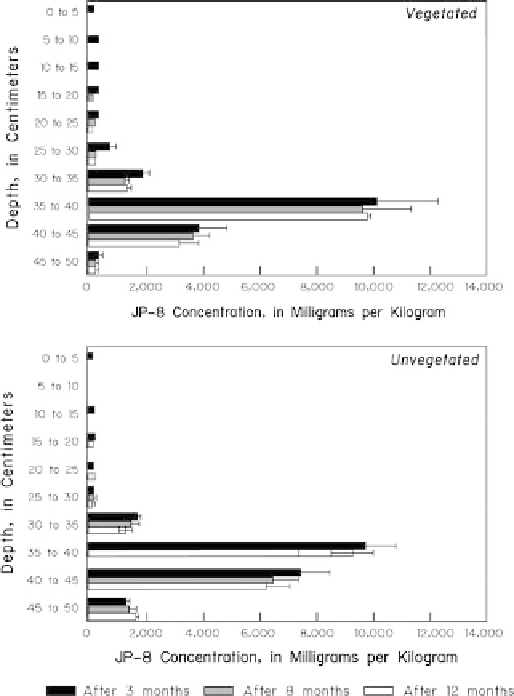Environmental Engineering Reference
In-Depth Information
delineate more precisely those contaminant biodegradation
processes that can be attributed to bioremediation or
phytoremediation and to describe when bioremediation is
enhanced by phytoremediation.
Aromatic hydrocarbons such as BTEX are found not only
in gasoline but in jet fuel as well. Jet fuel is used by both
commercial and military aircraft, and is derived from kero-
sene. Rather than stored in underground storage tanks like
automotive gasoline, jet fuel, or “av gas,” is stored in above
ground storage tanks (AST). Releases from ASTs, therefore,
tend to allow fuel to percolate down through the vadose zone
sediments to the water table.
Karthikeyan et al. (2003a) investigated the fate of jet fuel,
such as JP-8, in a laboratory study that measured the loss of
JP-8 added to different columns that either contained vege-
tation or did not. The vegetation studied was alfalfa
(
Medicago sativa
), horseradish (
Armoracia rusticana
), and
fescue grass (
Festuca arundinacea
). At the end of a 3-, 8-
and 12-month incubation of these plants with JP-8, the
amount of fuel that remained in the vegetated treatments
was only slightly less than in unvegetated treatments, where
the difference between treatments was
less
than 1%
(Figs.
13.1
and
13.2
).
What is interesting about this study is not the specific
results, which may differ depending on soil or plant selec-
tion, but that it raises the question of how exactly can
phytoremediation be defined? For example, phytoremedia-
tion can be defined solely as a plant-based process strictly
limited to plant-mediated processes (as defined in the intro-
duction to Chap. 1) or it can be a plant-assisted process, such
that the plant brings about conditions conducive to bioreme-
diation, similar to co-metabolism. For example, in the above
study in the vegetated treatment (Karthikeyan et al. 2003a)
an upward flux of the JP-8, toward to the root zone was
induced as a result of plant transpiration. This upward trans-
port of the JP-8 contaminants increases the probability that
oxic conditions in the subsurface will be encountered, as
well as aerobic microbial processes that will lead to the
oxidation of the jet fuel.
This upward advection of JP-8 was modeled using a 1-D
approach (Karthikeyan et al. 2003b). Also, the upward
movement of the contaminants might cause them to volatil-
ize more rapidly than at deeper depths. At the end of their
study, the loss of JP-8 was significant: up to 86% of that
originally added was gone after 5 months. The authors
concluded that the loss was due mostly to volatilization
and biodegradation and facilitated by vegetation.
A study where a primary goal was the planting of trees
over a source area to reduce recharge to the water table
occurred near Milwaukee, WI (McLinn et al. 2001). The
site was a former fuel tank farm adjacent to the Menomonee
River. Due to the glacial history of this area of the United
Fig. 13.1
The presence of plants did not greatly affect the removal
of jet fuel from contaminated sediments (Modified from Karthikeyan
et al. 2003a).
Fig. 13.2
The presence of plants did not greatly affect the removal of
jet fuel from contaminated sediments (Modified from Karthikeyan et al.
2003a).
States, the shallow aquifer was composed of low-permeabil-
ity till to a depth of 18 ft (5.4 m). Due to the activities at
the site, the soil and groundwater were contaminated by



Search WWH ::

Custom Search